Abstract
OBJECTIVES. This study compares characteristics, behaviors, and human immunodeficiency virus (HIV) infection in women who reported same-sex contact and women who had sex only with men. METHODS. Participants were patients attending a New York City sexually transmitted disease clinic. Structured questionnaires were administered by interviewers. RESULTS. Overall, 9% (135/1518) of women reported same-sex contact; among these, 93% also reported contact with men. Women reporting same-sex contact were more likely than exclusively heterosexual women to be HIV seropositive (17% vs 11%; odds ratio [OR] = 1.7, 95% confidence interval [CI] = 1.0, 2.6), to exchange sex for money/drugs (48% vs 12%, OR = 6.7, 95% CI = 4.6, 9.8), to inject drugs (31% vs 7%, OR = 6.3, 95% CI = 4.1, 9.5), and to use crack cocaine (37% vs 15%, OR = 3.3, 95% CI = 2.2, 4.8). HIV in women reporting same-sex contact was associated with history of syphilis (OR = 8.8), sex for crack (OR = 5.7), and injection drug use (OR = 4.5). CONCLUSIONS. In this study, women who reported same-sex contact were predominantly bisexual. They had more HIV risk behaviors and were more often HIV seropositive than women who had sex only with men. Among these bisexual women, heterosexual contact and injection drug use were the most likely sources of HIV. There was no evidence of female-to-female transmission.
Full text
PDF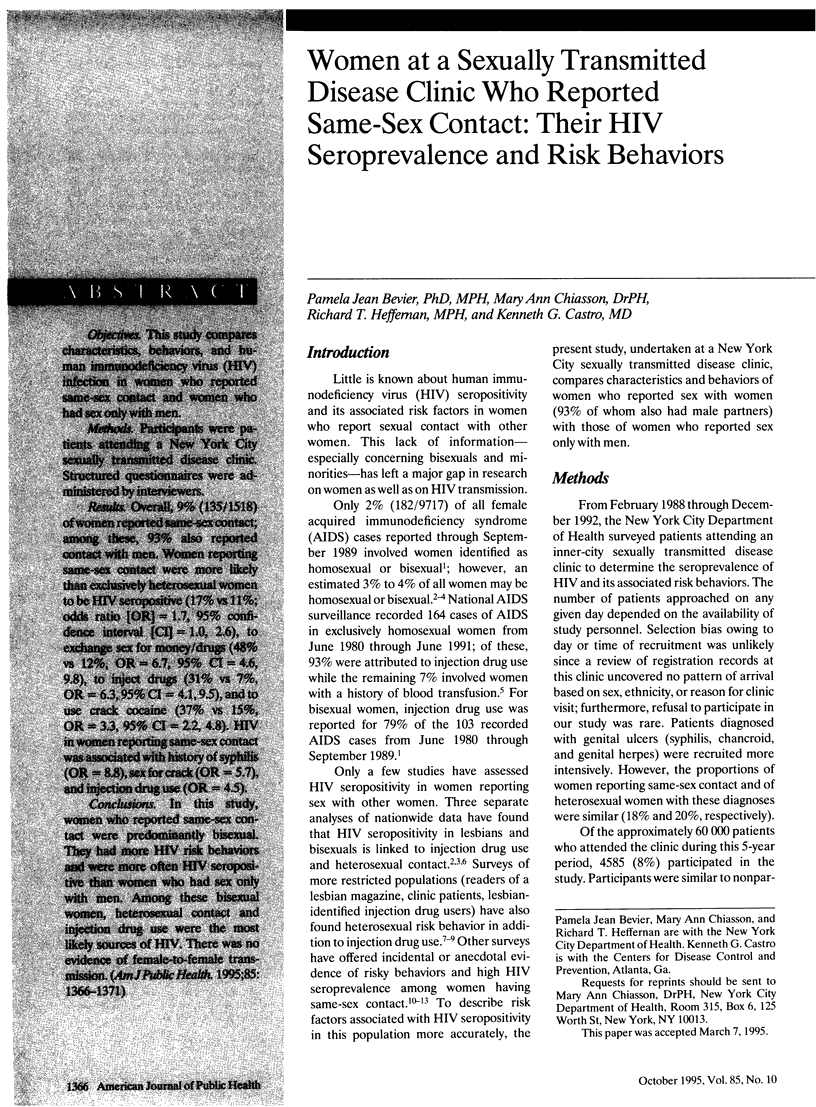
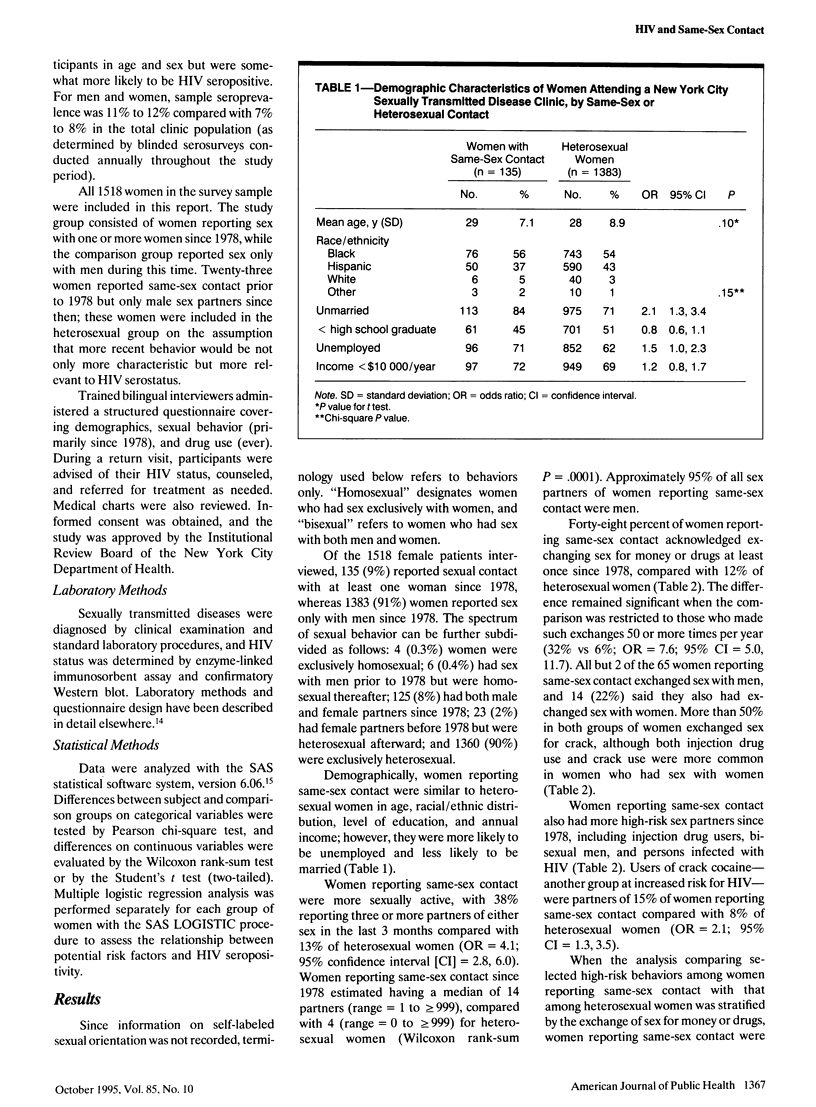
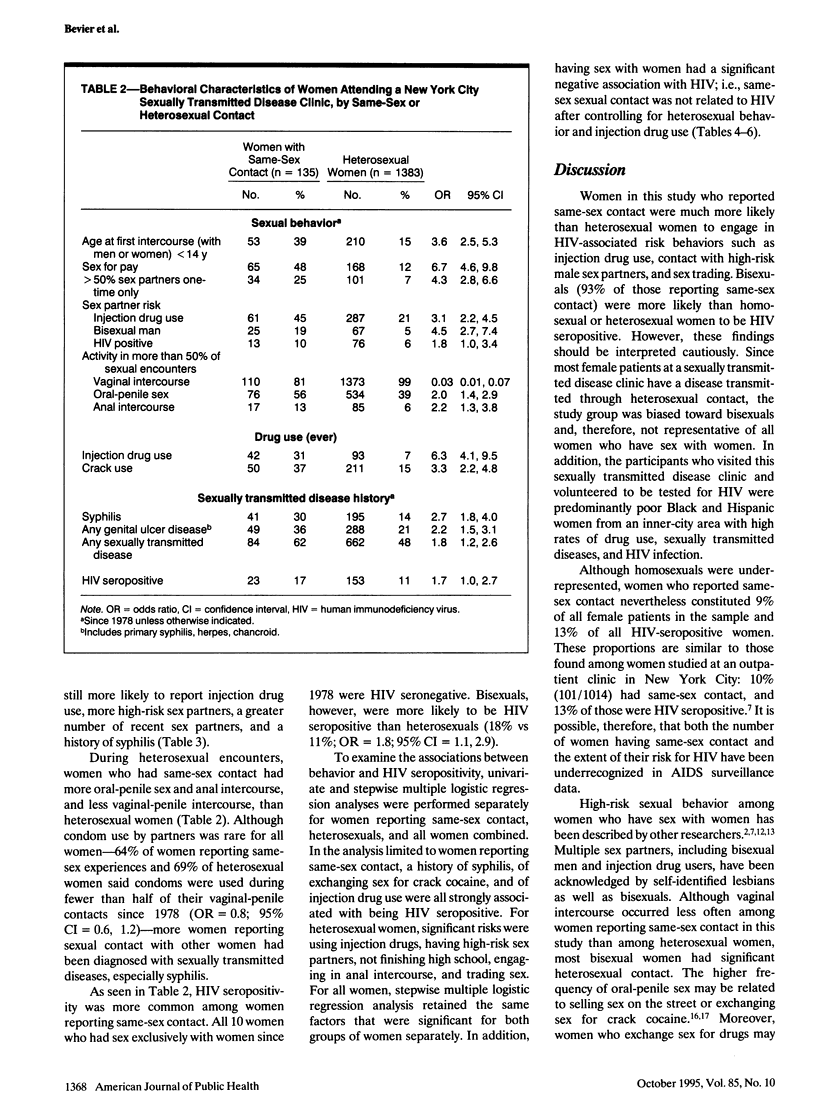
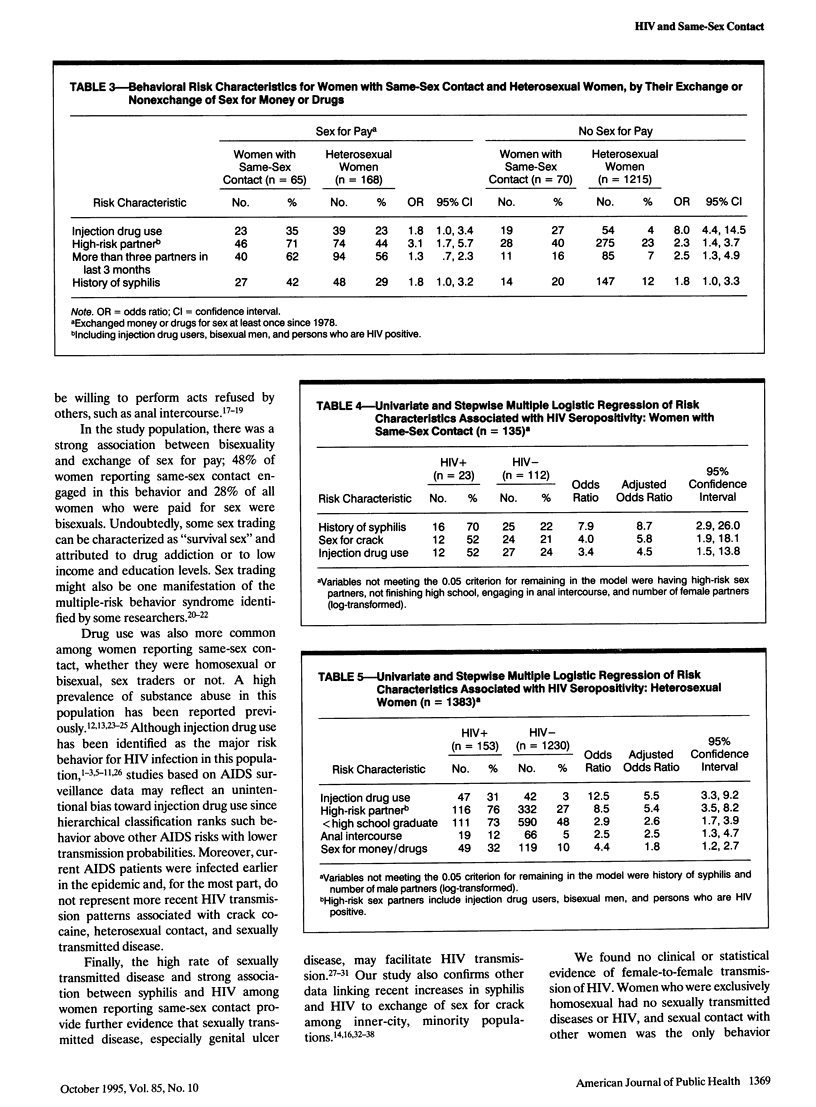
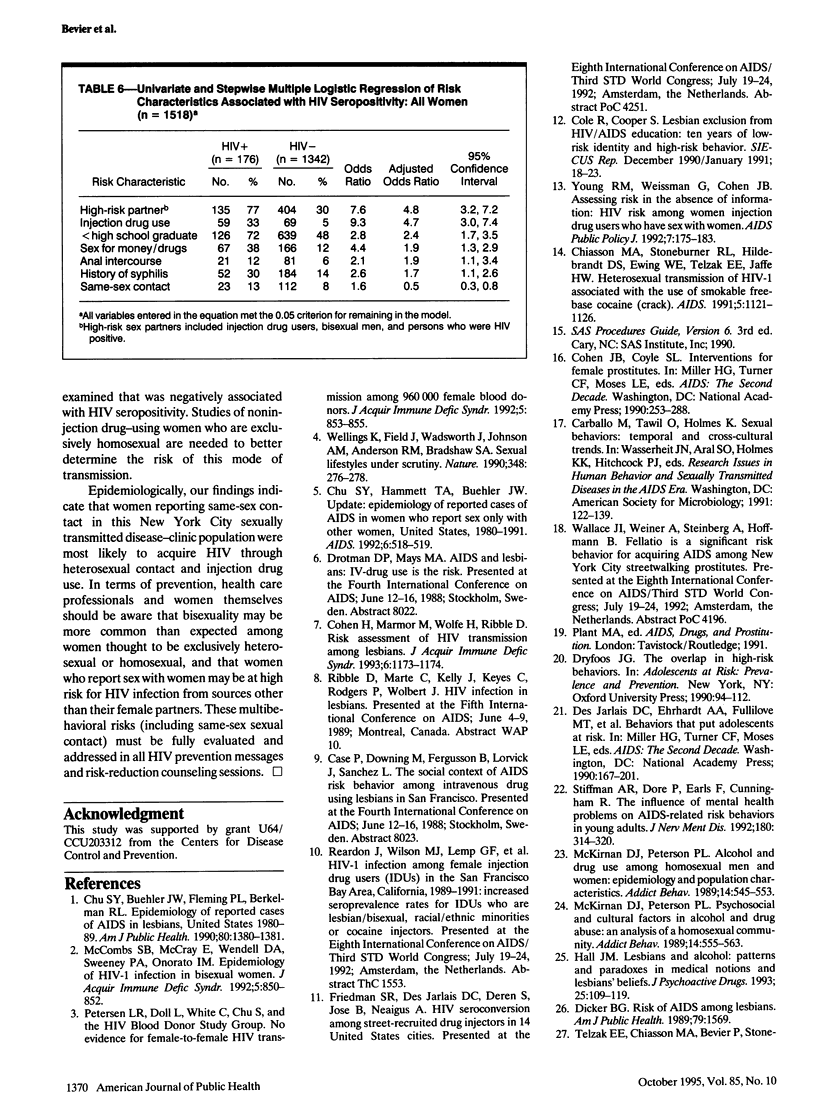
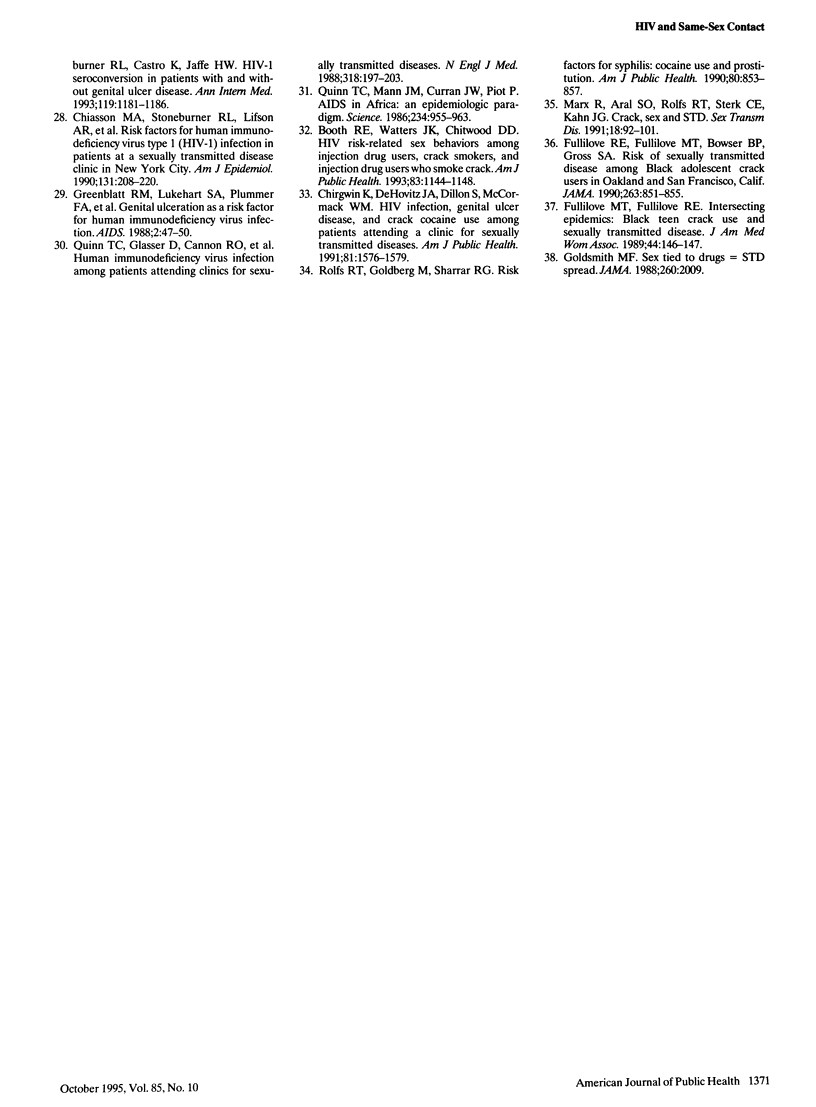
Selected References
These references are in PubMed. This may not be the complete list of references from this article.
- Booth R. E., Watters J. K., Chitwood D. D. HIV risk-related sex behaviors among injection drug users, crack smokers, and injection drug users who smoke crack. Am J Public Health. 1993 Aug;83(8):1144–1148. doi: 10.2105/ajph.83.8.1144. [DOI] [PMC free article] [PubMed] [Google Scholar]
- Chiasson M. A., Stoneburner R. L., Hildebrandt D. S., Ewing W. E., Telzak E. E., Jaffe H. W. Heterosexual transmission of HIV-1 associated with the use of smokable freebase cocaine (crack). AIDS. 1991 Sep;5(9):1121–1126. doi: 10.1097/00002030-199109000-00011. [DOI] [PubMed] [Google Scholar]
- Chiasson M. A., Stoneburner R. L., Lifson A. R., Hildebrandt D. S., Ewing W. E., Schultz S., Jaffe H. W. Risk factors for human immunodeficiency virus type 1 (HIV-1) infection in patients at a sexually transmitted disease clinic in New York City. Am J Epidemiol. 1990 Feb;131(2):208–220. doi: 10.1093/oxfordjournals.aje.a115491. [DOI] [PubMed] [Google Scholar]
- Chirgwin K., DeHovitz J. A., Dillon S., McCormack W. M. HIV infection, genital ulcer disease, and crack cocaine use among patients attending a clinic for sexually transmitted diseases. Am J Public Health. 1991 Dec;81(12):1576–1579. doi: 10.2105/ajph.81.12.1576. [DOI] [PMC free article] [PubMed] [Google Scholar]
- Chu S. Y., Buehler J. W., Fleming P. L., Berkelman R. L. Epidemiology of reported cases of AIDS in lesbians, United States 1980-89. Am J Public Health. 1990 Nov;80(11):1380–1381. doi: 10.2105/ajph.80.11.1380. [DOI] [PMC free article] [PubMed] [Google Scholar]
- Chu S. Y., Hammett T. A., Buehler J. W. Update: epidemiology of reported cases of AIDS in women who report sex only with other women, United States, 1980-1991. AIDS. 1992 May;6(5):518–519. [PubMed] [Google Scholar]
- Cohen H., Marmor M., Wolfe H., Ribble D. Risk assessment of HIV transmission among lesbians. J Acquir Immune Defic Syndr. 1993 Oct;6(10):1173–1174. [PubMed] [Google Scholar]
- Dicker B. G. Risk of AIDS among lesbians. Am J Public Health. 1989 Nov;79(11):1569–1569. doi: 10.2105/ajph.79.11.1569. [DOI] [PMC free article] [PubMed] [Google Scholar]
- Fullilove M. T., Fullilove R. E., 3rd Intersecting epidemics: black teen crack use and sexually transmitted disease. J Am Med Womens Assoc. 1989 Sep-Oct;44(5):146-7, 151-3. [PubMed] [Google Scholar]
- Fullilove R. E., Fullilove M. T., Bowser B. P., Gross S. A. Risk of sexually transmitted disease among black adolescent crack users in Oakland and San Francisco, Calif. JAMA. 1990 Feb 9;263(6):851–855. [PubMed] [Google Scholar]
- Goldsmith M. F. Sex tied to drugs = STD spread. JAMA. 1988 Oct 14;260(14):2009–2009. [PubMed] [Google Scholar]
- Greenblatt R. M., Lukehart S. A., Plummer F. A., Quinn T. C., Critchlow C. W., Ashley R. L., D'Costa L. J., Ndinya-Achola J. O., Corey L., Ronald A. R. Genital ulceration as a risk factor for human immunodeficiency virus infection. AIDS. 1988 Feb;2(1):47–50. doi: 10.1097/00002030-198802000-00008. [DOI] [PubMed] [Google Scholar]
- Hall J. M. Lesbians and alcohol: patterns and paradoxes in medical notions and lesbians' beliefs. J Psychoactive Drugs. 1993 Apr-Jun;25(2):109–119. doi: 10.1080/02791072.1993.10472240. [DOI] [PubMed] [Google Scholar]
- Marx R., Aral S. O., Rolfs R. T., Sterk C. E., Kahn J. G. Crack, sex, and STD. Sex Transm Dis. 1991 Apr-Jun;18(2):92–101. doi: 10.1097/00007435-199118020-00008. [DOI] [PubMed] [Google Scholar]
- McCombs S. B., McCray E., Wendell D. A., Sweeney P. A., Onorato I. M. Epidemiology of HIV-1 infection in bisexual women. J Acquir Immune Defic Syndr. 1992;5(8):850–852. doi: 10.1097/00126334-199208000-00016. [DOI] [PubMed] [Google Scholar]
- McKirnan D. J., Peterson P. L. Alcohol and drug use among homosexual men and women: epidemiology and population characteristics. Addict Behav. 1989;14(5):545–553. doi: 10.1016/0306-4603(89)90075-0. [DOI] [PubMed] [Google Scholar]
- McKirnan D. J., Peterson P. L. Psychosocial and cultural factors in alcohol and drug abuse: an analysis of a homosexual community. Addict Behav. 1989;14(5):555–563. doi: 10.1016/0306-4603(89)90076-2. [DOI] [PubMed] [Google Scholar]
- Petersen L. R., Doll L., White C., Chu S. No evidence for female-to-female HIV transmission among 960,000 female blood donors. The HIV Blood Donor Study Group. J Acquir Immune Defic Syndr. 1992;5(9):853–855. [PubMed] [Google Scholar]
- Quinn T. C., Glasser D., Cannon R. O., Matuszak D. L., Dunning R. W., Kline R. L., Campbell C. H., Israel E., Fauci A. S., Hook E. W., 3rd Human immunodeficiency virus infection among patients attending clinics for sexually transmitted diseases. N Engl J Med. 1988 Jan 28;318(4):197–203. doi: 10.1056/NEJM198801283180401. [DOI] [PubMed] [Google Scholar]
- Quinn T. C., Mann J. M., Curran J. W., Piot P. AIDS in Africa: an epidemiologic paradigm. Science. 1986 Nov 21;234(4779):955–963. doi: 10.1126/science.3022379. [DOI] [PubMed] [Google Scholar]
- Rolfs R. T., Goldberg M., Sharrar R. G. Risk factors for syphilis: cocaine use and prostitution. Am J Public Health. 1990 Jul;80(7):853–857. doi: 10.2105/ajph.80.7.853. [DOI] [PMC free article] [PubMed] [Google Scholar]
- Stiffman A. R., Doré P., Earls F., Cunningham R. The influence of mental health problems on AIDS-related risk behaviors in young adults. J Nerv Ment Dis. 1992 May;180(5):314–320. doi: 10.1097/00005053-199205000-00005. [DOI] [PubMed] [Google Scholar]
- Telzak E. E., Chiasson M. A., Bevier P. J., Stoneburner R. L., Castro K. G., Jaffe H. W. HIV-1 seroconversion in patients with and without genital ulcer disease. A prospective study. Ann Intern Med. 1993 Dec 15;119(12):1181–1186. doi: 10.7326/0003-4819-119-12-199312150-00005. [DOI] [PubMed] [Google Scholar]
- Wellings K., Field J., Wadsworth J., Johnson A. M., Anderson R. M., Bradshaw S. A. Sexual lifestyles under scrutiny. Nature. 1990 Nov 22;348(6299):276–278. doi: 10.1038/348276a0. [DOI] [PubMed] [Google Scholar]


